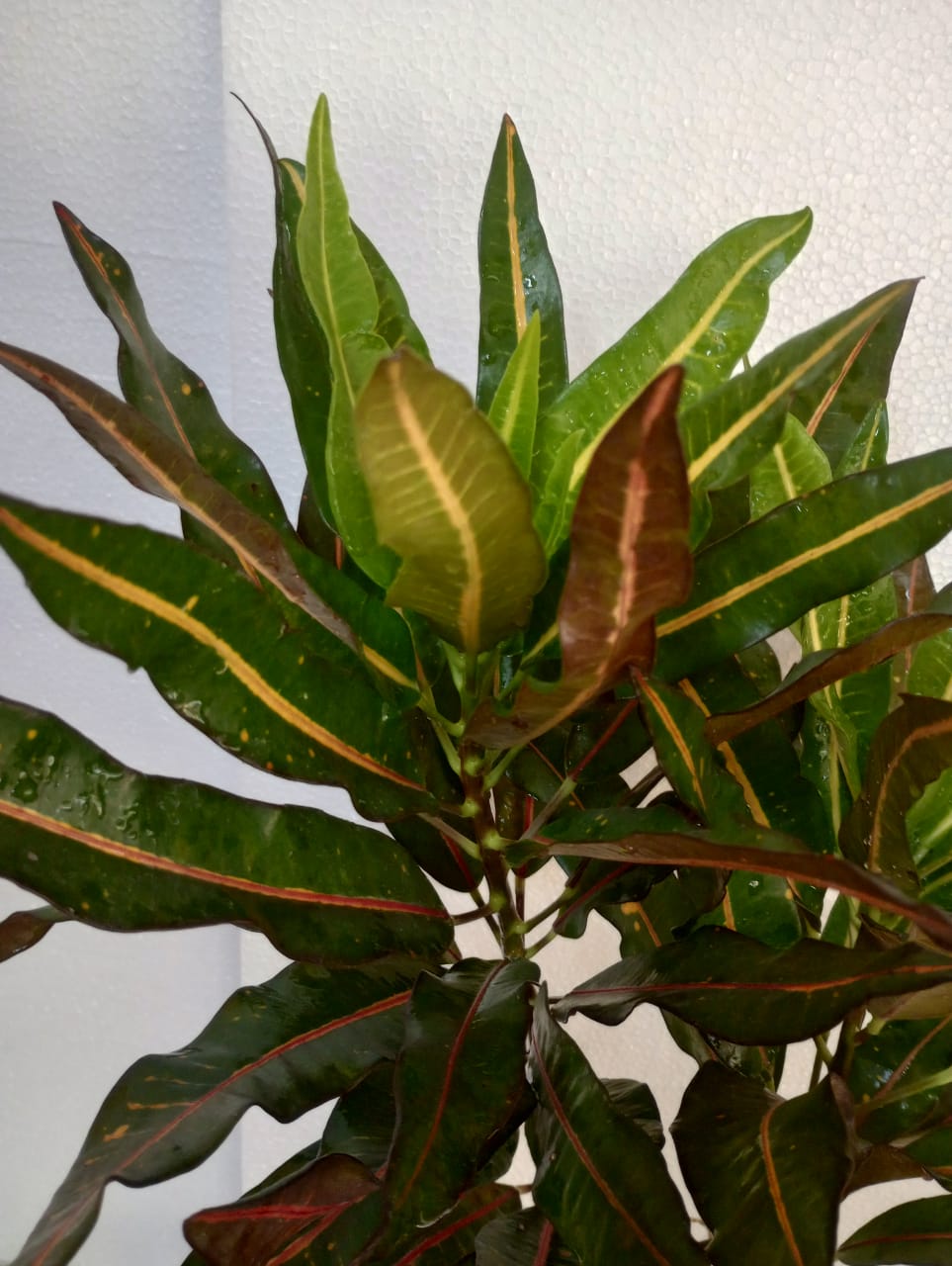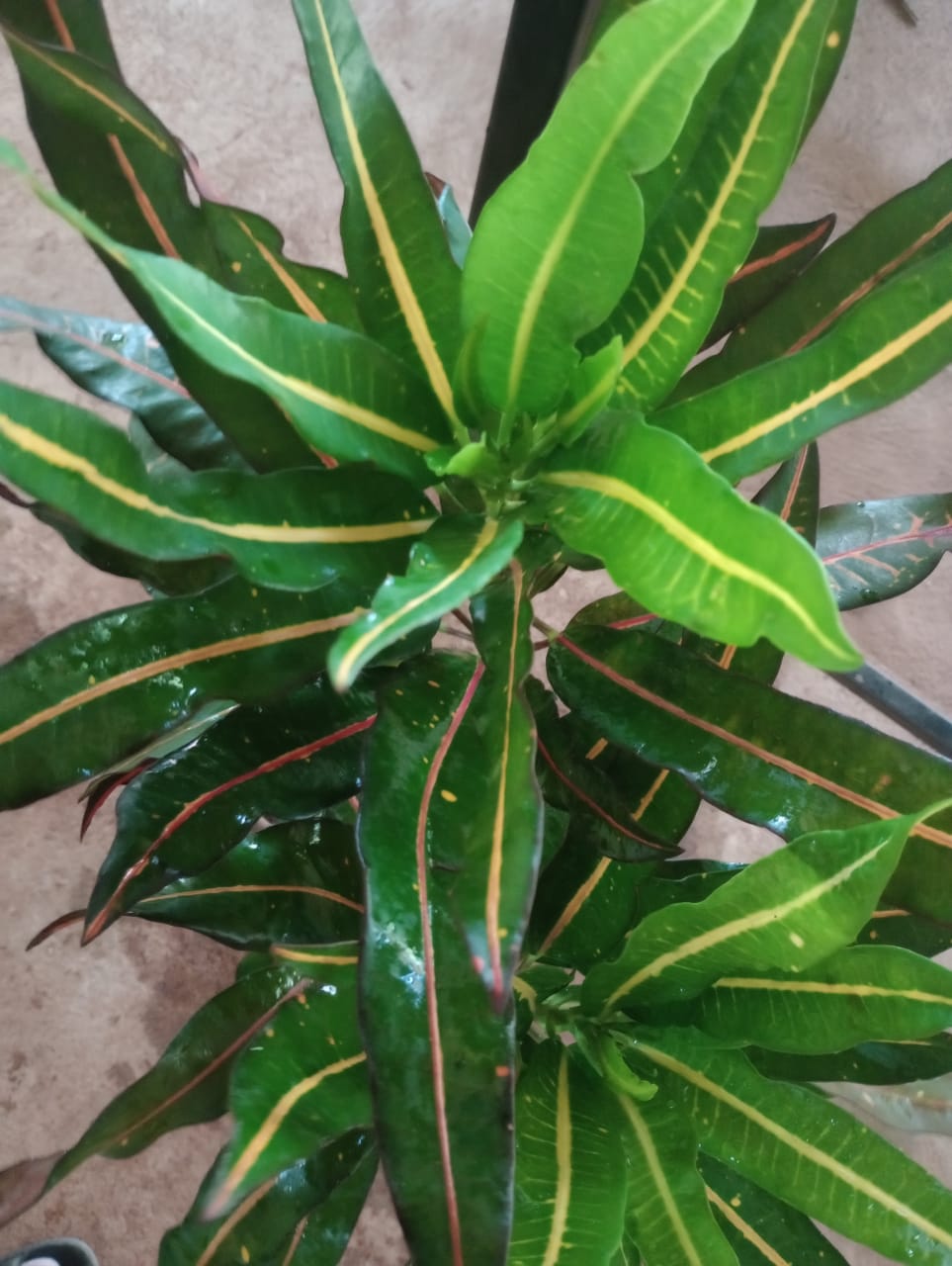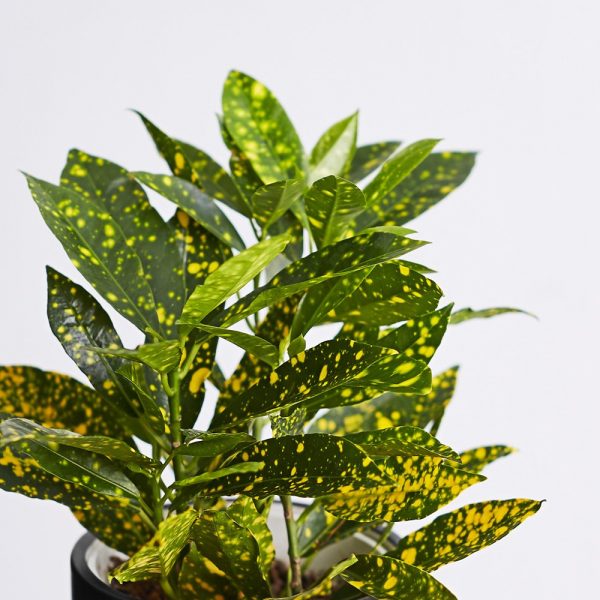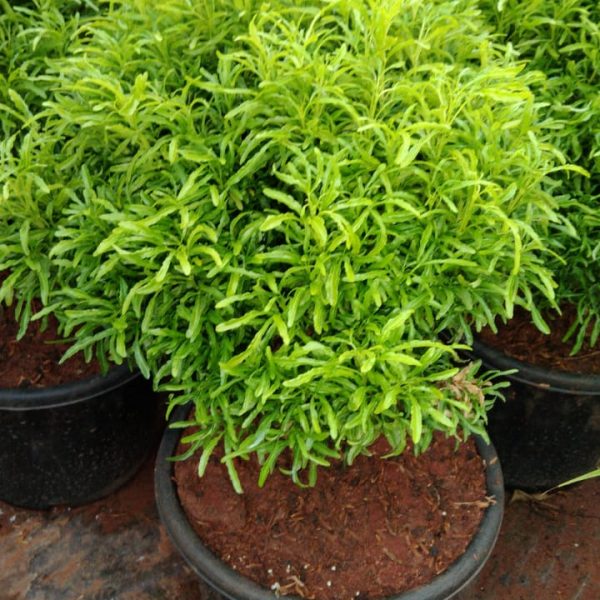The croton plant (Codiaeum variegatum) has colorful variegated foliage and nearly limitless leaf forms. As evergreens in USDA hardiness zones 11 and 12, they are often grown outdoors as ornamental shrubs. In their native habitat, crotons like humid, warm conditions with dappled light and plentiful water. These plants are difficult to please indoors. Outdoor plants can reach 10 feet in height, but pot-grown specimens tend to be much smaller, making them suitable for permanent houseplants or indoor/outdoor container plants. Generally, croton grows relatively slowly, gaining less than 12 inches of height per growing season.
When growing croton plants indoors, the primary challenge is maintaining the ideal temperature because if it is too cold, they start losing leaves. However, crotons are well worth the effort for their explosion of color. Croton can be planted any time of year, depending entirely on the temperatures remaining consistently 70 to 80 degrees Fahrenheit indoors, outdoors, or in a greenhouse. Crotons are toxic to humans and animals.
Croton Care
A well-grown croton keeps its leaves down to the soil level—and the trick to this is to provide steady warmth. Even in outdoor settings, crotons drop leaves after a cold night. Vibrant leaf colors depend on the quality of light; they need lots of bright, shifting sunlight.
Low humidity inside the house makes crotons particularly susceptible to spider mites. Mist the plants daily to avoid an infestation. Crotons can be brought outdoors when temperatures remain above 50 F, provided they are properly acclimated to the light and temperature conditions.
Light
Crotons need bright, indirect light. Some may not tolerate unfiltered, direct sunlight and tend to thrive in dappled sunlight. Vibrant colors depend on if it gets sufficient bright light. If the plant lacks the light it requires, the leaves will turn green.
Water
Keep them evenly moist in the summer. Croton plants need about one inch of water per week. Reduce watering in the winter to biweekly. Watch the plant for signs that it needs more water, such as wilting young foliage. Increase watering if the wilting noticeably happens during hot weather, but check the top couple of inches of soil with a finger for moisture before you increase water. If it’s still moist, hold off on watering. Mist frequently during the growth period.
Soil
A well-drained, moist soil that has been enriched with compost is ideal. This plant prefers humus-rich, acidic soil.
Temperature and Humidity
Keep the room above 60 degrees Fahrenheit, and do not expose the plant to cold drafts. Humidity, along with the lack of bright light, also affects the color of the leaves. Keep the humidity level at 40 to 80 percent. If the humidity isn’t high enough, the plant may drop some of its leaves. If you have trouble maintaining the moisture in your home at this level, run a humidifier in the room or set a humidity tray beneath the plant and group it with other plants.
Fertilizer
Apply slow-release pellets three times per growing season: early spring, mid-summer, and early fall. Or, you can use a liquid fertilizer every other month during the growing season from early March to the end of September. Since fertilizers vary widely by type, read the package instructions for feeding quantity. In most cases, if you intend to feed on a regular schedule, you can reduce the package-suggested amount by half strength. Then, observe the plant’s growth rate over the next month; you can adjust and add or reduce fertilizer depending on how vigorous you want your plants to grow. Stop giving fertilizer during the winter months.
Since this plant prefers slightly acidic soil, use acidifying fertilizers that contain ammonium nitrate, ammonium sulfate, or sulfur-coated urea. Your best target NPK ratios are 3-1-2 and 8-2-10 (nitrogen-phosphorus-potassium).
Types of Croton Plant
There are hundreds of croton varieties, with names like ‘Dreadlocks,’ ‘Ann Rutherford,’ ‘Mona Lisa,’ and ‘Irene Kingsley.’ For a plant with such incredible diversity, it’s impressive that there is only one species (C. variegatum). Each plant is unique due to this plant’s genetic instability and variability; enthusiastic collectors highly prize unusual varieties. Crotons are often classified by leaf type: curling, twisted, oak leaf, narrow, broad, and oval. A few notable varieties include:
- C. variegatum var. pictum: Large, brightly colored leaves of orange, red, bronze, green, purple, and yellow; grows 3 to 6 feet tall as a houseplant
- C. variegatum ‘Gold Star’: Narrow, linear leaves of green with bright yellow spotting; has a tree-like habit and grows to only about 20 inches in height
- C. variegatum ‘Petra’: A prevalent variety with oval, green leaves with pronounced veining in pink, red, orange, and yellow hues; it can reach 3 to 6 feet in height
Propagating Croton Plant
You can propagate croton plants any time of year; the codependent factor is temperature. In tropical locales where the temperature remains consistently in the 70 to 80 F range, you can propagate croton plants year-round outdoors. Similarly, you can propagate indoors or in a greenhouse if you can maintain those temperatures. Crotons do not grow well from seed, as the plant is unstable, and the offspring won’t resemble the parent. Crotons are easily propagated with stem cuttings. Stem cuttings encourage new growth and will control the size of the plant. Use a rooting hormone on your stem-cut ends to increase the odds of rooting success.
Crotons sometimes produce “sports,” or shoots, that are entirely different from the parent plant. These offshoots can be potted up independently, and only cuttings reproduce a plant identical to the parent. Here’s how to propagate your croton by division:
- You will need sterile pruners, well-draining commercial potting soil (sand, peat moss, and a vermiculite mixture), a growing pot, and rooting hormone (optional). You do not need a pot if you plant directly in the ground in tropical environments.
- Using sharp, clean pruning shears, cut a 4- to 6-inch stem with the circumference of a pencil at a 45-degree angle right above a leaf node. The cutting should have at least three leaves.
- Optional: For a higher rate of rooting success, dip the cutting in rooting hormone at the cut point.
- Plant the cutting in moistened soil about 1 to 1.5 inches deep. Put the plant in a warm, sunny spot away from cold drafts. Keep the soil moist but not soggy. You can enclose the pot in a clear plastic bag to create a greenhouse atmosphere to increase rooting success. After one week, remove the plastic bag.
- Roots should develop in four weeks. If you notice new growth, the plant has rooted. You can also test rooting by giving the cutting a gentle tug. If it feels taut, it has set roots. Once a plant has rooted, it’s ready for transplanting to a larger pot or a spot inground.
Potting and Repotting Croton Plant
Repot a young croton every year in the spring or early summer for the first three growing seasons. After that, only repot when you notice roots growing out of the drainage holes or see roots growing at the soil level. Get a container with ample drainage holes. It should be only one size larger than the plant’s current container. Put one to two inches of damp peat-based potting soil into the bottom of the new container.
Remove the plant from its old container by turning the croton on its side and gently sliding it out of its container. Set it in the center of the new pot. Fill in around the roots with potting soil. Water the plant and add additional soil if needed to bring the soil level to about one inch below the rim of the new container.
Overwintering
Crotons are sensitive to cold weather. If you live in a location that sometimes gets freezing temperatures or infrequent cold snaps, you should consider maintaining your plants in pots and bringing them indoors during temps that plunge lower than 50 F.
To protect in-ground specimens during unexpected cold weather, add about two inches of mulch around the base of the plant to insulate the roots. Use gardener’s blankets to keep the frost away. Use stakes to keep the blankets from weighing down the leaves and branches. These coverings keep in the warmth and protect against ice and harsh winds. Ensure the coverings are staked well or weighted down, so they do not blow away with the wind.
Common Pests & Plant Diseases
Croton is susceptible to a few plant diseases and pests. Crown gall is a common bacterial infection that affects croton. Crown gall appears like thick, swollen growths on the croton’s stems and the veins of its leaves. If your plant gets this disease, it’s recommended that you pull up the plant, discard it, and sterilize the container and gardening tools. It can spread to other plants and leave a wake of destruction in its path.
Anthracnose is a fungal infection that is sometimes called leaf spot or leaf blight. It makes tan-colored spots on the leaves. Cut off any infected foliage and avoid letting the leaves touch other plants since its spores can spread. If most of the plant looks affected, treat the plant with a standard copper-based garden fungicide.
The insects that like croton include mealybugs, spider mites, scales, and thrips. Use pesticides to remove these pests or less harsh alternatives like horticultural oil or insecticidal soap. If left untreated, leaf growth may get stunted, leaves will drop, and the plant can eventually die.
How to Get Croton to Bloom
All crotons are capable of making tiny star-shaped flowers on long thin stems when grown outdoors. However, croton plants rarely flower when grown indoors. The flower stem looks like a feathery vine, and the tiny blooms don’t have a scent. They can flower any time of year, but it will likely happen when conditions are ideal, such as bright sun, enriched and acidic soil, moist but not soggy soil, and temps in the 70 to 80 F range. Also, relocating an indoor plant outdoors when the temperatures are warm may spur flower production.
Common Problems With Croton Plant
Crotons are finicky plants. Cool breezes, insufficient humidity, and poor soil or insufficient nutrients will affect the health of this plant and can invite a host of problems, including pests, diseases, and a lackluster appearance. Control its environment as best as you can to keep your plant thriving.
Dull Leaf Coloration
The plant’s most vibrant colors come with bright light, but the temperatures must not be sweltering. Summer in tropic zones might be a little too much for some croton. Reduce or hold off on applying fertilizer during a heatwave or higher temps. Intensely hot days will stress out croton and may cause graying or flat colors. Fans or air ventilation can cool down the leaves and will help preserve the health of the leaves. Check water levels and don’t let the plant dry out during periods of high heat.
Curling or Rolling Leaves
Leaves can roll or twist when the leaves get large and the color is flat or full. To fix this, reduce fertilizer. The plant is likely growing too quickly and may need more light to grow properly. Move the plant to a location with more lighting if you can.
Leaf Drop
Crotons will drop their leaves at any hint of cool temperatures or cool drafts. Bring in the plant if your plant is in a pot outdoors and the forecast calls for temperatures dipping below 50 F. Insect activity can also cause leaves to fall, namely mites and mealybugs. Inspect the undersides of leaves closely for tiny eggs or insects. You’ll need to clean off the leaves with insecticidal soap or treat the affected areas with horticultural oil to remove the pests.







Reviews
There are no reviews yet.